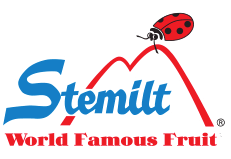Recycling at Stemilt
|
A few weeks ago, I toured our company’s recycling operations to experience first-hand all that is done to reduce, reuse, and recycle at Stemilt. I was blown away by what I saw and simply had to share the experience with you.
Steve Hisel, director of operations at Stemilt, took me on the recycling tour. We started at our Olds Station facility so I could see how materials are collected for recycling on the packing lines. There are bins on the line that are designated for different recyclables, including: culled fruit (rot), leaves, cardboard, plastic, paper, and metal. Green waste is taken to Stemilt Hill to be composted and eventually applied as fertilizer to trees, while the rest of the bins, and used light bulbs, batteries, and oil, are delivered to the recycling shop to be sorted and sold.
Bill Redmon is the recycling coordinator at Stemilt. His job is to sort through and sell all of Stemilt’s recyclables, and manage a huge inventory of used parts and equipment. Every day brings something different, and virtually everything passed onto the recycling shop is recycled or reused. I found it amazing that with everything that comes in from the plants, Bill only has one dumpster at his disposal to send trash to, and that dumpster is only emptied once a week!
It’s not uncommon for Bill to gather a truckload of one material. In fact, Bill had just sent 40,000 pounds of plastic on a truck to be recycled the morning I toured.
Reusing materials and equipment is also a big part of recycling here. Bill organizes and catalogs all of the used parts and equipment at Stemilt. By disposing of very little and knowing what is on hand, our company isn’t immediately forced to buy new parts or equipment when the need for a particular item arises.
The examples of reusing are vast: recycled oil is used to heat the shop where Stemilt trucks are tuned and repaired, conveyor belts from dismantled packing lines are kept until they are needed in a new installation, and a variety of used parts (motors, pumps, valves, etc.) are on hand for mechanics to use when the need arises on a packing line. Bill also manages a website to sell Stemilt’s used parts and equipment to other companies.
Stemilt also has a great recycling/reuse partnership with its local fiber tray manufacturer. We send recycled newsprint, paper, and cardboard to the company to regenerate the materials into fiber trays used in apple packing. Approximately 51% of Stemilt’s annual needs for fiber trays come from our own recycled materials!
As you can see, recycling and reusing is an important part of our operations here at Stemilt, and also a key initiative of our sustainability and social responsibility program, Responsible Choice. Now it’s your turn to talk recycling with us. How do you incorporate recycling or reusing into your daily life? Let us know in the comments below!
